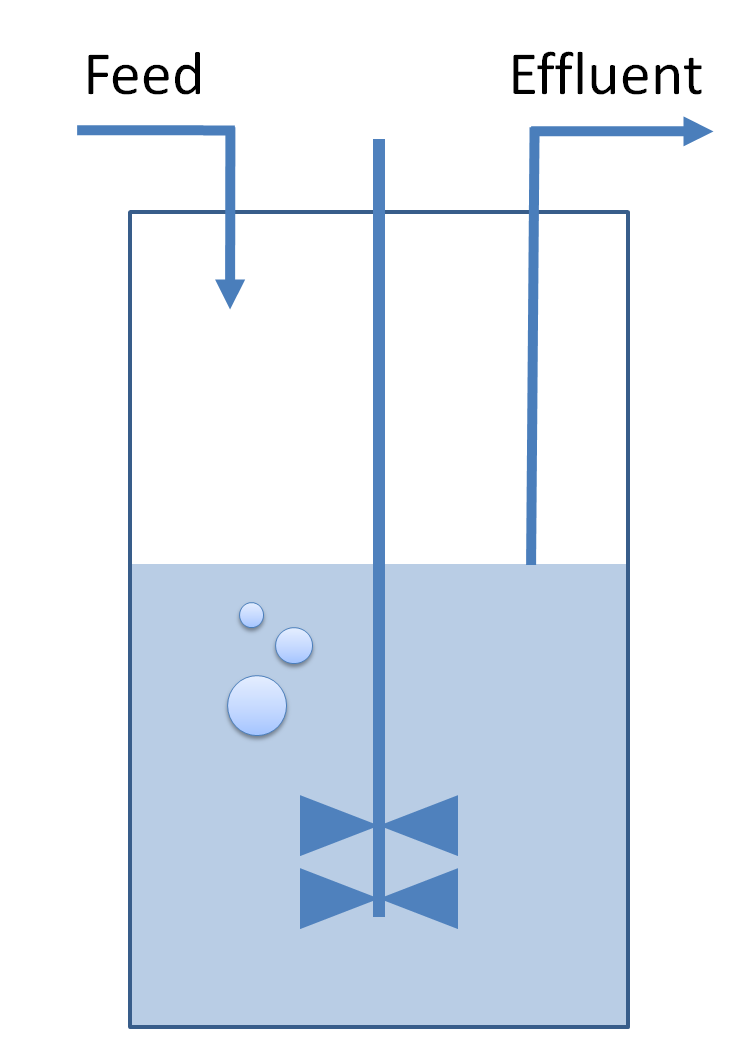|
Model Construction
Introduction
We are interested to understand the factors that account for an oscillating behaviour at population level. We build two models to study systems that are equipated with quorum sensing capabilities but that relay on different designs principles.
joint our quest for alternatives...
|
Same environment |
|
|
|
|
|
Same starting point |
|
|
The core system |
|
|
We keep 3 interactions |
|
|
Same quorum sensing mechanism |
|
|
lasI indirectly activates envZ via HSL |
|
| Alternative One |
Alternative Two |
 Two copies of envZ Two copies of envZ |
 No modifications, i.e. a single copy of envZ No modifications, i.e. a single copy of envZ |
 One of the copies of envZ is activated by FlhDC and Flia One of the copies of envZ is activated by FlhDC and Flia |
 lasI is activated by FlhDC and Flia lasI is activated by FlhDC and Flia |
 EnvZ inhibits the expression of lasI EnvZ inhibits the expression of lasI |
 EnvZ does not inhibit the expression of lasI EnvZ does not inhibit the expression of lasI |
 This system ends up with 2 modules This system ends up with 2 modules |
 This system consists of a single module This system consists of a single module |
| Bimodular System |
Unimodular System |
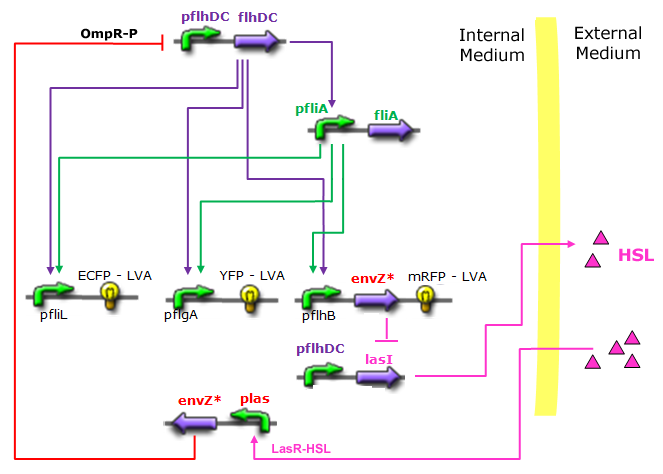 Core system coupled with an oscillator Core system coupled with an oscillator |
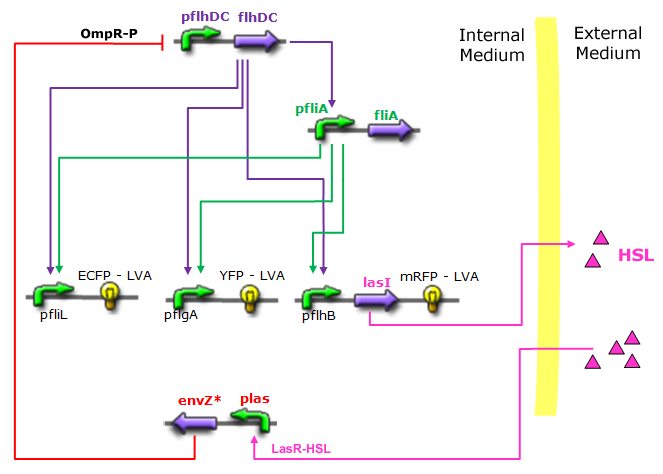 Modified core system that accounts for quorum sensing Modified core system that accounts for quorum sensing |
Modeling Alternatives
The proposed models are:
- In the one model, we use a modular design. We consider that the core system is one of the modules of the system. In adittion, the other module is an two gene oscillator system presented in [Garcia-Ojalvo] that accounts for quorum sensing. We call this alternative the 'bimodular system'.
- In the other model, namely the 'unimodular system', we rewire the architecture of the core system to have the desired functionality of the system in a single circuit.
Both the bimodular and unimodular models describe events that happend not only at the cellular level (as in the core system) but also at the population level due to interactions needed bettwen a cell and its environment during quorum sensing.
In the following sections, we first describe the population modeling (the common part amoung our two proposed models) to then focus our attention to the characteristics that are exclusive to each of the modeling alternatives.
Description
|
Common Dynamics: |
|
|
|
|
|
|
|
|
|
|
| Bimodular System |
Unimodular System |
 Core system coupled with an oscillator Core system coupled with an oscillator |
 Modified core system that accounts for quorum sensing Modified core system that accounts for quorum sensing |
↓ more detailed description... ↑
|
Common Dynamics: Chemostat |
|
|
The variation of cells' concentration in the chemostat over time can be expressed in terms of a production (positive) term and degradation (negative) terms: |
|
|
|
|
|
For the production term, we use a logistic equation to model cell growth, according to standard assumptions. The behaiviour obtained is the following one: at low population density, the concentration of cells in the chemostat (c) increase exponentialy with a growth rate αcell and at high population density, the population reaches a maximum concentration, cmax.
|
|
|
For the degradation term, we consider that c decrease proportionaly to both a dilution phenomena cause by the renewal of the medium in the chemostat (Drenewal) and cell death (d).
|
|
|
Common Dynamics: Quorum Sensing |
|
|
In order to model the quorum sensing dynamics, we consider that: |
|
|
1) Inside a cell, the HSL concentration increases proportionaly to the concentration of LasI and decreases according to both a degradation term (proportional to the internal HSL concentration) and a transport term (proportional to the difference beetwen the internal and external concentration of HSL). Thus, the equation for the internal HSL concentration is: |
|
|
|
|
|
2) Outside the cells, HSL is cumulated with the same transport term tah we use in the previous equation. The degradation of HSL in the external medium and the dilution controled via the chemostat accounts for HSL external decrease. So the external HSL concentration is given by: |
|
|
|
|
|
that is equivalent to: |
|
|
 |
|
|
where  and and  |
|
|
Common Network Dynamics: FlhDC and Flia |
|
|
FlhDC and Flia are regulated in the same way in both systems. FlhDC is produced under the influence of EnvZ via an inhibition. Flia is regulated for its self and FlhDC. |
|
|
 |
|
| Bimodular System |
Unimodular System |
| a) The expression of lasI is under the control of the same promotor that used for FlhDC. |
a) The expression of lasI is regulated by FlhDC and Flia (as in the core system). |
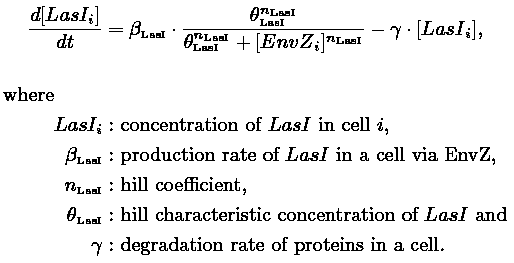 |
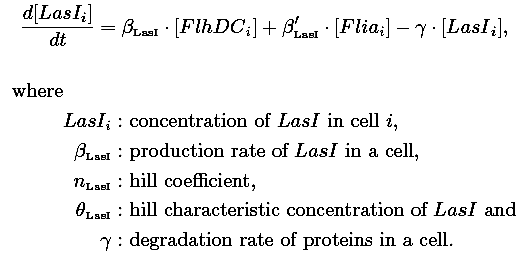 |
| b) The expression of envZ depends on both the activation from FlhDC and Flia (as in the core system) and the concentration of HSL present in the cell. |
b) The expression of envZ varies as a function of the concentration of HSL present in the cell. |
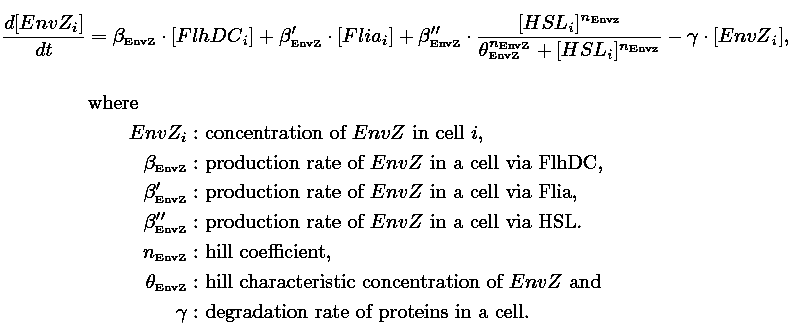 |
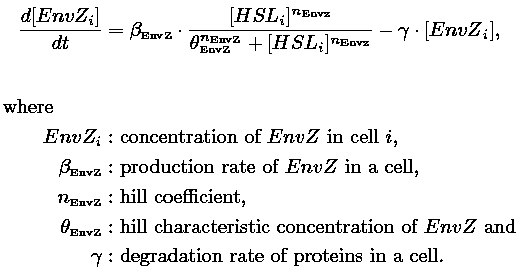 |
|
|
Parameters Search
The following table sumarize our findings. The parameters' values that are used during the simulations. Most them are found in literature others are obtained from further analysis.
| Parameters
|
|
|
| Chemostat
| Parameter
| Meaning
| Original Value
| Normalized Value
| Unit
| Source
|
|
| αcell
| Growth rate
| 0.0198
| 1
| min-1
| wet-lab
|
| cmax
| Carrying capacity for cell growth
| 0.1
| 0.1
| µm3
| [3]
|
| Drenewal
| Dilution rate
| 0.00198
| 0.1
| min-1
| wet-lab ([3])
|
| d
| Death rate
| 0.0099
| 0.5
| min-1
| wet-lab
|
|
|
| Quorum Sensing
| Parameter
| Meaning
| Original Value
| Normalized Value
| Unit
| Source
|
|
| γHSL
| Degradation rate
| 0.0053
| 0.2690
| min-1
| wet-lab
|
γHSLext
| Degradation rate
| 0.0106
| 0.5380
| min-1
| [6]
|
| βHSL
| Production rate
| 0.3168
| 16
| min-1
| ∅
|
| η
| Diffusion rate
| 10
| 505
| min-1
| [2]
|
| nHSL
| Hill coefficient
|
| 4
|
| [3]
|
| θHSL
| Hill characteristic concentration for the second operator
|
| 0.5
| c.u
| [3]
|
|
 "
"

